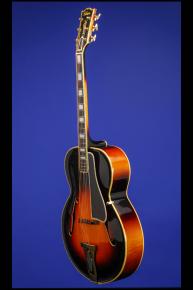Buddy Raye's 1938 Gibson Advanced L-5.
1938 Gibons Advanced L-5.
This majestic guitar weighs just 5.80 lbs. and has a body width of 17 inches and a body depth of just under 3 3/8 inches. Two-piece X-braced carved spruce top. Two-piece book-matched curly maple back and curly maple sides. Two-piece book-matched curly maple neck with a center mahogany strip, a nut width of just under 1 11/16 inches, a scale length of 25 1/2 inches and a huge really thick profile. Multi-bound ebony fretboard with a small, graceful point at the end of the fretboard, twenty original jumbo frets, and inlaid pearl block position markers. Five-ply binding on the top of the guitar, three-ply binding on the back, and single-bound f-holes. Multi-bound headstock with the pre-war "Gibson" thick script pearl logo inlaid across the face of the headstock and with the pearl "L-5" flowerpot inlay. Bound plastic bell-shaped truss-rod cover with two screws. Individual Grover Imperial tuners with metal 'stairstep' shaped buttons. Multi-bound pearloid pickguard. Rosewood bridge with height-adjustable pre-set compensating saddle on rosewood base. Original 'hinged' L-5 tailpiece with "L-5" engraved at end and silver-plated, engraved metal insert. The tailpiece is additionally engraved on the cross-bar with the name "Buddy Raye". Inside the bass f-hole is the original oval white Gibson label with the style number "L-5" and the serial number "95570" stamped in black. There is a slight (hidden) crack on the top just to the bass side of the center seam which runs from the bridge to the tail-end - this crack is only visible when the tailpiece is removed. One very small crack in top binding on waist of bass-side. FON number "U 98 D" stamped in black with a red pencil "3" following the "D". Housed in its original five-latch shaped 'tweed-style' linen covered Lifton hardshell case with blue plush lining (8.75). This guitar originally belonged to Buddy Raye, his name is etched on the tailpiece. This guitar is almost identical to Al Viola's 1939 Advanced L-5 (our stock #00996).
Buddy Raye (1918-1945) was part of a musical family who performed in Vaudeville under the name of Reed. When Vaudeville bookings dried up after movies rose in popularity, the family team broke up but Buddy and his sister continued with a two-act, she singing and making comic patter, he accompanying her on guitar. Their duet died with Vaudeville.
Buddy Raye stayed in the entertainment business. His lively personality and skill made him a welcome addition to the Art Mineo Trio, Art on bass, Joe Lombardo on accordion. Soon they were booked everywhere. The gigs, however, didn’t last long. Buddy was a heavy drinker and was often unable to perform. Despite this, "everybody loved him. He was a great guitar player,” Art declared. They kept getting bookings.
One day in 1936 Buddy needed to pick up his sister at Grand Central Station. “Everybody in the world was there,” Art remembered. Rhythm on the Range was a big hit feature film and the New York showing was that night. Starring Bing Crosby, the movie featured singer, actress and comedienne Martha Raye in her film debut. Martha was Buddy Raye’s sister and ex-partner. Art remembered Martha fondly, “Oh, she was stacked,” Art said, “And could she sing.”
Buddy moved to Hollywood but Art Mineo and Joe Lombardo decided not to join him. He joined Bob Wills and His Texas Playboys c. 1938, playing this guitar (seen in a session photo) and doubling on fiddle. As a member of Diamond's Solid-Aires, he appeared in the movie Strictly in the Groove (1942) and can be seen playing this ax. Buddy was dead by the time he was 27. He acquired this Advanced L-5 new in 1938 and played it until his death.
"The L-5 was designed as an accompaniment instrument for orchestra, small group, and solo settings. At the time of its introduction, there was no other guitar made by any manufacturer that even remotely resembled the L-5 in overall form or function. Soon after its auspicious debut in 1923, the L-5 became one of Gibson's all-time great guitars, a milestone in the evolution of the carved-top instrument and a major contributor to American acoustic and electric music… Gibson repeated their marketing strategy of 1923-1924 again in 1934, when they introduced the Super 400 guitar and the Advanced line of 17-inch wide carved-top guitars, including the Advanced L-5. Once Gibson had simultaneously introduced the Super 400 and the Advanced L-5, the evolution of the L-5 and Super 400 guitars was strikingly similar… The Advanced L-5 was produced from later 1934 through 1941. As with the Super 400, several variations of this instrument appeared with the standard 17-inch width at the lower bout… The three main variations of the prewar 17-inch L-5 are the X-braced version made from 1934-1939; the later parallel-braced version made from 1939-1941; and the cutaway or Premiere version, also made from 1939-1941. From 1935-1941, a total of approximately 1,005 prewar acoustic L-5 guitars were shipped from the Gibson factory. Included in this number are 752 X-braced instruments. (Thomas A Van Hoose. The Gibson Super 400 [and The Gibson L-5], pp. 99-102).












